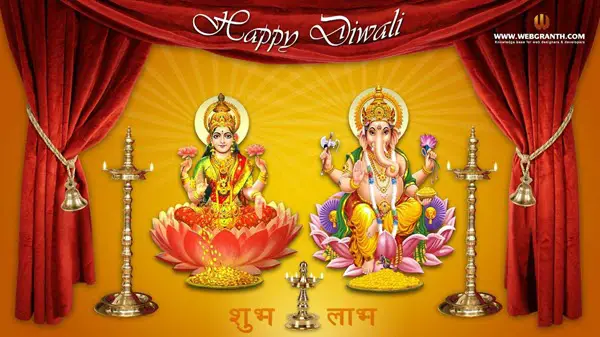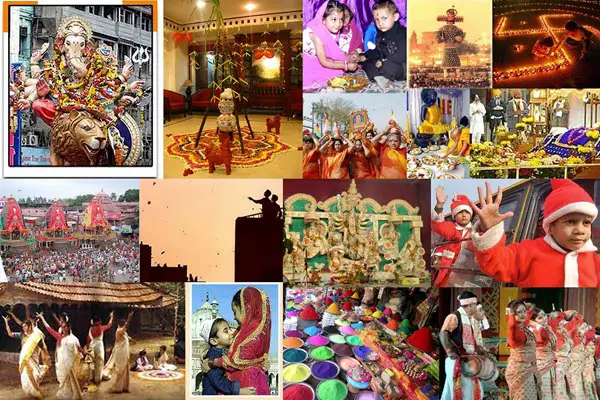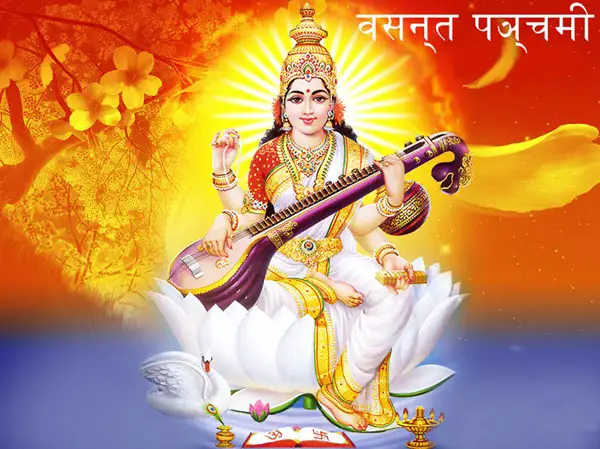Varalakshmi Pooja Vratam is a festival that is dedicated to Goddess Lakshmi. On this occasion, devotees worship Goddess Lakshmi, the consort of Lord Vishnu and one of the Hindu Trinity. The post shares with you Varalakshmi Pooja Vratam Importance and date.
Varalakshmi is a form of Goddess Lakshmi that grants boons (known as “Vara”). Goddess Lakshmi is said to grant boons to all those devotees that perform the Varalakshmi Pooja with utmost devotion on this day.
Married Hindu women mainly perform the Varalakshmi Pooja Vratam to appease Goddess Mahalakshmi. This Varalakshmi Vrat is celebrated in many parts of India, including Maharashtra, Karnataka, Andhra Pradesh, Telangana, Tamil Nadu, and Uttar Pradesh.
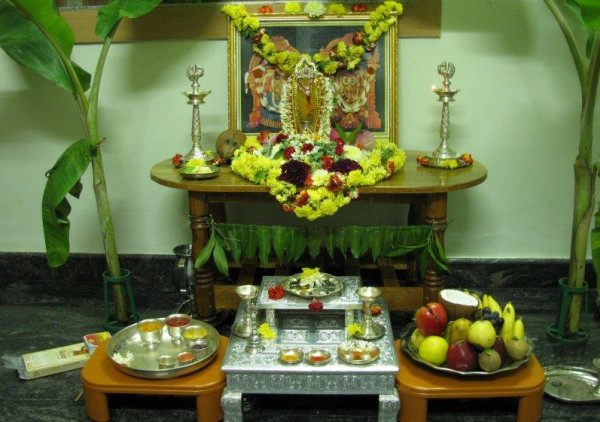
It is believed that worshiping Goddess Mahalakshmi on this day is equivalent to worshipping all the eight forms of Ashtalakshmi that are known by the name –
- Shri – Goddess of Wealth
- Bhu – Goddess of Earth
- Saraswati – Goddess of Learning
- Priti – Goddess of Love
- Kirti – Goddess of Fame
- Shanti – Goddess of Peace
- Tushti – Goddess of Pleasure
- Pushti- Goddess of Strength
The Varalakshmi Pooja Vratam is performed for the welfare of the family members. The Vrata is kept for the husband’s long life and to get children and many other boons such as wealth, prosperity, peace, pleasure, fame, etc.
This Varalakshmi Pooja Vratam is observed in the Hindu month of Shravana. So, it falls in July or August, according to the English Calendar. It is kept on Friday that precedes the full moon day on Poornima.
However, those who cannot perform the Vrata on that day can keep the fast and perform the Pooja on any other Friday that falls in that month. The married Hindu women keep the fast till they finish the Varalakshmi Pooja.
On this occasion of Varalakshmi Pooja and Vratam, the married Hindu women worship Goddess Lakshmi with utmost devotion. They offer the deity fruits, sweets, and flowers. They also keep the Kalasam (representing the deity), decorated with a saree, flowers, and gold jewelry, and the offerings are placed in front.
For example, a Rakshai or Saradu, known as the sacred thread, is among the offerings adorned on women’s wrists once the Pooja is completed. This sacred thread is worn and signifies protection and piety. Plus, several articles are given as gifts to Sumangali that are in good faith.
Moreover, the Pooja is performed with no restriction to caste and creed. The Varalakshmi Pooja is performed to get Goddess Lakshmi’s blessings in the form of wealth and the family’s well-being. Women also pray to be blessed with children.
Table of Contents
Importance of Varalakshmi Pooja
(Why do we do Varalakshmi Pooja?)
The Varalakshmi Pooja and Vratam celebrate the eight forms of Goddess Lakshmi, who is worshipped on this occasion as:
- Vijaya Lakshmi (Goddess of Victory)
- Vidhya Lakshmi (Goddess of Wisdom)
- Dhaanya Lakshmi (Goddess of Nourishment)
- Shoubhagya Lakshmi (Goddess of Prosperity)
- Santana Lakshmi (Goddess of Progeny)
- Dhana Lakshmi (Goddess of Wealth)
- Aadi Lakshmi (Goddess of Protection)
- Dhairaya Lakshmi (Goddess of Courage)
All these eight forces of Goddess Lakshmi are known as Ashta Lakshmi. Lord Vishnu is called the “Ashtalakshmi Pati.” He is believed to radiate these forces from him to preserve the Universe. Lord Vishnu is said to be the preservative aspect of the Universe.
These eight forces are personified as Lakshmis. The Hindus believe that health, wealth, and prosperity depend on the rhythmic play of these forces called Lakshmi.
It is considered that worshiping these forces (Lakshmi) helps to get prosperity, protection, wealth, nourishment, and other boons for a happy and fulfilled life. The festival of Varalakshmi is observed to invoke the blessings of Goddess Lakshmi.
The Hindu married women keep the Varalakshmi Vratam and invoke the blessings of Goddess Lakshmi on them, their husbands, and their children.
Varalakshmi Pooja Vratam is mainly a festival for women, which is being celebrated by women only. The importance of Varalakshmi Vratam has been described in the Skanda Puran.
So, Varalakshmi Pooja is a day to seek Goddess Lakshmi’s divine blessings, and she is the presiding deity of prosperity, wealth, wisdom, fortune, generosity, and fertility. The married women perform this Vrata to receive her divine grace.
The Story of Varalakshmi Pooja Vratam
The story goes that once upon a time, there lived a Brahmin woman named Charumathi in the kingdom of Magadha. She was a pious lady who was devoted to her husband and family.
Goddess Mahalakshmi was impressed by her devotion to her family and appeared in her dream. She told Charumathi to worship Goddess Varalakshmi (a form of Goddess Lakshmi) to fulfill all her wishes. She should perform the worship on the Friday in the Shravana month that precedes the night of the full moon.
When Charumathi told them about the dream to her family, they encouraged her to do the Pooja. Many other women in their village also joined her and traditionally performed the Pooja. They offered many sweets to the Goddess Varalakshmi and chanted sacred chants such as:
पद्मसने पद्मकरे
सर्व लोकैक पूजिते।
नारायणप्रिये देवि
सुप्रीता भव सर्वदा॥
Since then, married women have practiced the Varalakshmi Vratam for their family’s welfare and the long life of their husbands.
Rituals for the Varalakshmi Pooja Vratam
Devotees start preparing for the Varalakshmi Pooja Vratam one day preceding the Vrata, a Thursday. They assemble all the essentials that are required to perform the Pooja.
On Friday (the day for the Varalakshmi Vratam), the devotees get up early in the morning and get ready after bathing. The most preferred time for getting up in the morning to perform the puja is “Brahma Muhurta,” which is the time before sunrise.
The devotees clean their houses and the surrounding area and perform the morning rituals. They decorate the puja site with beautiful Kolam or Rangoli.
Now, they begin to prepare the “Kalash” for the Pooja ceremony. For this, you can choose either a silver or bronze pot. It is thoroughly cleaned and smeared with sandalwood paste.
After this, a “Swastika” symbol is drawn on the Kalasha. It is filled with water or raw rice, one lime, some coins, beetle nut, and five different kinds of leaves. However, the choice of items filled inside the “Kalash” varies from region to region. For instance, turmeric, black beads, mirror, comb, and black bangles fill the pot in some regions.
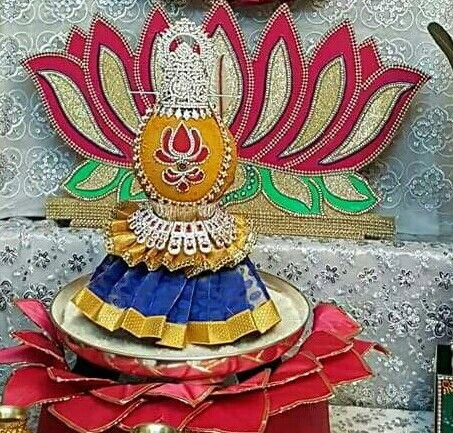
Now, the Kalash’s neck is covered with a clean cloth, and its mouth is then covered with mango leaves. Lastly, a coconut is kept on the mouth of the Kalasha. The picture of Goddess Lakshmi is stuck on the coconut or drawn using turmeric powder. This Kalash symbolizes Goddess Varalakshmi and is worshipped, keeping full devotion.
This Kalash is then placed on a heap of rice. The devotees begin the Pooja ceremony by worshipping Lord Ganesh. They perform the Varalakshmi Pooja by chanting slokas from “Lakshmi Sahasranama,” sung in praise of Goddess Lakshmi.
Devotees also prepare special sweets at home for offerings to Goddess Varalakshmi. In the Southern States of India, devotees prepare Pongal that Goddess Lakshmi offers as Prasad. Finally, Aarti is done on the Kalash. During this Pooja, women tie a yellow thread over their hands.
In some regions, devotees place a mirror behind the Kalasha. Nowadays, readymade Kalash pots are also available in the market that can be used for the Varalakshmi Pooja Vratam.
The women that observe the Varalakshmi Vrat abstain from eating any food. However, this custom varies from region to region. In some regions, the devotees keep the fast until the end of the Puja ceremony.
On Saturday (the day after Puja), the devotees have a bath and dismantle the Kalash used for the Puja. The water inside the Kalash is sprinkled all over the house, and the rice (if used) is mixed with the rice stored in the house.
Auspicious time to Perform the Varalakshmi Puja
The most auspicious time for performing the Varalakshmi Pooja is in the morning before 10:30 am or in the afternoon. However, the Pooja should be avoided in the Rahu Kaal. The time that is from 10:30 am to 12:00 pm in the noon is considered as Rahu Kaal.
Fasting Period: The fasting during the Varalakshmi Puja begins on Friday morning from sunrise and lasts till the Pooja is completed.
List of Pooja Samagri required for Varalakshmi Pooja
- Kalash
- Goddess Lakshmi Picture
- New blouse pieces for Kalash
- Mango leaves garland
- Akshata – Rice mixed with turmeric
- Kumkum
- Chandan
- Turmeric powder
- Betel leaves
- Bananas
- Dry Fruits
- Fruits and Flowers
- Coconut
- Panch amrita
- Milk
- Naivedyam (Payasam, Kesari Baath, Jaggery Rice, etc.)
What to do on Varalakshmi Vrat?
Devotees of Goddess Lakshmi, especially married women, keep a fast on the day of Varalakshmi Puja for their husbands’ welfare. The Varalakshmi Vrat is kept on the last Friday ahead of Raksha Bandhan during the Shravan Shukla Paksha period.
Usually, fasting is done without taking any grains but only on water. However, if it is difficult for you to keep fast on water, you can take fruits and milk. You should visit a Lakshmi Temple and offer prayers. If a temple is far away, you can worship the Goddess at home with lotus, roses, fruits, and Dhoop in the early morning hours.
You can even use energized Lakshmi Yantra for worshipping Goddess Lakshmi. You should meditate on Goddess Lakshmi and chant her seed mantra: “Om Hreem Shreem Lakshmibhayo Namah.” You can even chant the Lakshmi Mantra using Lotus Seed Bead.
Devotees also perform the Mahalakshmi Puja under qualified Brahmins. It is one of the most important activities for this day. Other Pooja activities include Kalash Sthapana, Gauri Ganesh Poojan, Navagraha Pooja, Laxmi Yantra Pooja, Lakshmi Mantra Jaap, Invocation of major Gods and Goddesses in Kalash, Aarti, and Pushpanjali.
You can wear Seven Mukhi Rudraksha Beads as Goddess Lakshmi rules them. It will strengthen your willpower as well as prove useful in attracting financial opportunities for you.
Can Unmarried Girls Do Varalakshmi Vratham?
Varalakshmi Pooja Vratham is celebrated in honor of Goddess Lakshmi. Along with married Hindu women who perform the Varalakshmi Pooja Vratam for the welfare of their husbands, children, and all family members, unmarried girls can also do fasting on Varalakshmi Vratham day.
Varalakshmi is a form of Goddess Lakshmi who grants boons. Vrata and Puja’s rituals are performed on this day to get the blessings of Goddess Lakshmi.
Varalakshmi Vratam Puja Date 2024
Varalakshmi Vratam Puja is observed to get Goddess Lakshmi’s blessings, who is the consort of Lord Vishnu and the bestower of wealth and prosperity.
The Puja is performed on the second Friday or on Friday that falls just before Poornima (full moon day) in the Hindu month of Shravan. So, it falls in the months of July and August, according to the English Calendar.
Varalakshmi Vratam will be celebrated on 16th August 2024, Friday.
Here, we share with you Varalakshmi Puja Muhurat:
- Simha Lagna Puja Muhurta: 05:57 AM to 08:14 AM
- Vrishchika Lagna Puja Muhurta: 12:50 PM to 03:08 PM
- Kumbh Lagna Puja Muhurta: 06:55 PM to 08:22 PM
- Vrishabha Lagna Puja Muhurta: 11:22 PM to 01:18 AM, 17th August
According to the Electional Astrology, the most appropriate time for Goddess Lakshmi’s worship is during “Fixed Lagna.” If Lakshmi Puja is performed during fixed Lagna, then Goddess Lakshmi will bless the devotee with long-lasting prosperity.
Here, we have shared with you four Puja timing in a day during which Fixed Lagna prevails. So, you can choose any of the above timing at your convenience. However, the evening time, during which the Pradosh Kaal prevails is the most appropriate for worshiping Goddess Lakshmi.
Well, with this, we have reached the end of this post on Varalakshmi Pooja Vratam. We hope that the information provided above proves useful to you. Thanks for your visit. Please share the post across popular social media channels. We welcome your comments and suggestions.

